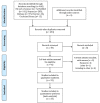Exposure to Low Levels of Radiofrequency Electromagnetic Fields Emitted from Cell-phones as a Promising Treatment of Alzheimer's Disease: A Scoping Review Study
- PMID: 36818013
- PMCID: PMC9923247
- DOI: 10.31661/jbpe.v0i0.2109-1398
Exposure to Low Levels of Radiofrequency Electromagnetic Fields Emitted from Cell-phones as a Promising Treatment of Alzheimer's Disease: A Scoping Review Study
Abstract
Background: Alzheimer's disease (AD) is one of the most significant public health concerns and tremendous economic challenges. Studies conducted over the past decades show that exposure to radiofrequency electromagnetic fields (RF-EMFs) may relieve AD symptoms.
Objective: To determine if exposure to RF-EMFs emitted by cellphones affect the risk of AD.
Material and methods: In this review, all relevant published articles reporting an association of cell phone use with AD were studied. We systematically searched international datasets to identify relevant studies. Finally, 33 studies were included in the review. Our review discusses the effects of RF-EMFs on the amyloid β (Aβ), oxidative stress, apoptosis, reactive oxygen species (ROS), neuronal death, and astrocyte responses. Moreover, the role of exposure parameters, including the type of exposure, its duration, and specific absorption rate (SAR), are discussed.
Results: Progressive factors of AD such as Aβ, myelin basic protein (MBP), nicotinamide adenine dinucleotide phosphate (NADPH) oxidase, and neurofilament light polypeptide (NFL) were decreased. While tau protein showed no change, factors affecting brain activity such as glial fibrillary acidic protein (GFAP), mitogen-activated protein kinases (MAPKs), cerebral blood flow (CBF), brain temperature, and neuronal activity were increased.
Conclusion: Exposure to low levels of RF-EMFs can reduce the risk of AD by increasing MAPK and GFAP and decreasing MBP. Considering the role of apoptosis in AD and the effect of RF-EMF on the progression of the process, this review indicates the positive effect of these exposures.
Keywords: Alzheimer’s Disease; Cellphone; Dementia; Neurodegenerative Diseases; Non-Ionizing Radiation.
Copyright: © Journal of Biomedical Physics and Engineering.
Conflict of interest statement
None
Figures
Similar articles
-
Effects of 1950 MHz radiofrequency electromagnetic fields on Aβ processing in human neuroblastoma and mouse hippocampal neuronal cells.J Radiat Res. 2018 Jan 1;59(1):18-26. doi: 10.1093/jrr/rrx045. J Radiat Res. 2018. PMID: 29040655 Free PMC article.
-
The Effects of Mobile Phone Radiofrequency Electromagnetic Fields on β-Amyloid-Induced Oxidative Stress in Human and Rat Primary Astrocytes.Neuroscience. 2019 Jun 1;408:46-57. doi: 10.1016/j.neuroscience.2019.03.058. Epub 2019 Apr 3. Neuroscience. 2019. PMID: 30953670
-
Impact of Cerebral Radiofrequency Exposures on Oxidative Stress and Corticosterone in a Rat Model of Alzheimer's Disease.J Alzheimers Dis. 2020;73(2):467-476. doi: 10.3233/JAD-190593. J Alzheimers Dis. 2020. PMID: 31796670
-
The effect of exposure to radiofrequency fields on cancer risk in the general and working population: A systematic review of human observational studies - Part I: Most researched outcomes.Environ Int. 2024 Sep;191:108983. doi: 10.1016/j.envint.2024.108983. Epub 2024 Aug 30. Environ Int. 2024. PMID: 39241333
-
The effects of radiofrequency exposure on male fertility: A systematic review of human observational studies with dose-response meta-analysis.Environ Int. 2024 Aug;190:108817. doi: 10.1016/j.envint.2024.108817. Epub 2024 Jun 11. Environ Int. 2024. PMID: 38880061
Cited by
-
Long-Term Impact of Using Mobile Phones and Playing Computer Games on the Brain Structure and the Risk of Neurodegenerative Diseases: Large Population-Based Study.J Med Internet Res. 2025 Jan 28;27:e59663. doi: 10.2196/59663. J Med Internet Res. 2025. PMID: 39874583 Free PMC article.
-
Electromagnetic Field Stimulation Therapy for Alzheimer's Disease.Neurology (Chic). 2024;3(1):1020. Epub 2024 Jan 5. Neurology (Chic). 2024. PMID: 38699565 Free PMC article.
-
A Novel Design of a Portable Birdcage via Meander Line Antenna (MLA) to Lower Beta Amyloid (Aβ) in Alzheimer's Disease.IEEE J Transl Eng Health Med. 2025 Apr 10;13:158-173. doi: 10.1109/JTEHM.2025.3559693. eCollection 2025. IEEE J Transl Eng Health Med. 2025. PMID: 40657533 Free PMC article.
-
Neurostimulation devices to treat Alzheimer's disease.Explor Neurosci. 2025;4:100674. doi: 10.37349/en.2025.100674. Epub 2025 Feb 25. Explor Neurosci. 2025. PMID: 40084342 Free PMC article.
-
Should Parents Allow Their Children Use Smartphones and Tablets? The Issue of Screen Time for Recreational Activities.J Biomed Phys Eng. 2023 Dec 1;13(6):563-572. doi: 10.31661/jbpe.v0i0.535. eCollection 2023 Dec. J Biomed Phys Eng. 2023. PMID: 38148959 Free PMC article.
References
-
- Mander BA, Winer JR, Jagust WJ, Walker MP. Sleep: A Novel Mechanistic Pathway, Biomarker, and Treatment Target in the Pathology of Alzheimer’s Disease? Trends Neurosci. 2016;39(8):552–66. doi: 10.1016/j.tins.2016.05.002. [ PMC Free Article ] - DOI - PMC - PubMed
-
- Lee JK, Kim NJ. Recent Advances in the Inhibition of p38 MAPK as a Potential Strategy for the Treatment of Alzheimer’s Disease. Molecules. 2017;22(8):1287. doi: 10.3390/molecules22081287. [ PMC Free Article ] - DOI - PMC - PubMed
-
- Irwin K, Sexton C, Daniel T, Lawlor B, Naci L. Healthy Aging and Dementia: Two Roads Diverging in Midlife? Front Aging Neurosci. 2018;10:275. doi: 10.3389/fnagi.2018.00275. [ PMC Free Article ] - DOI - PMC - PubMed
Publication types
LinkOut - more resources
Full Text Sources
Miscellaneous


